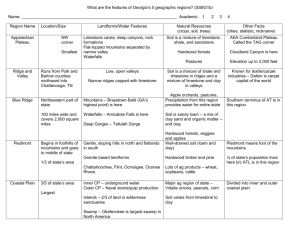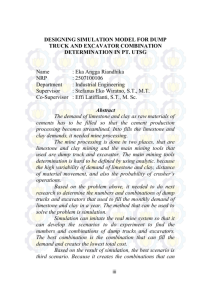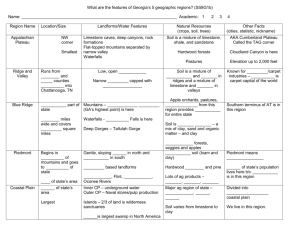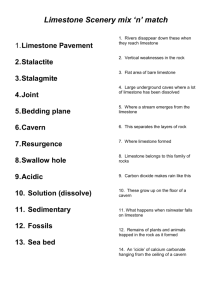Fossilization and Glade Limestone
advertisement
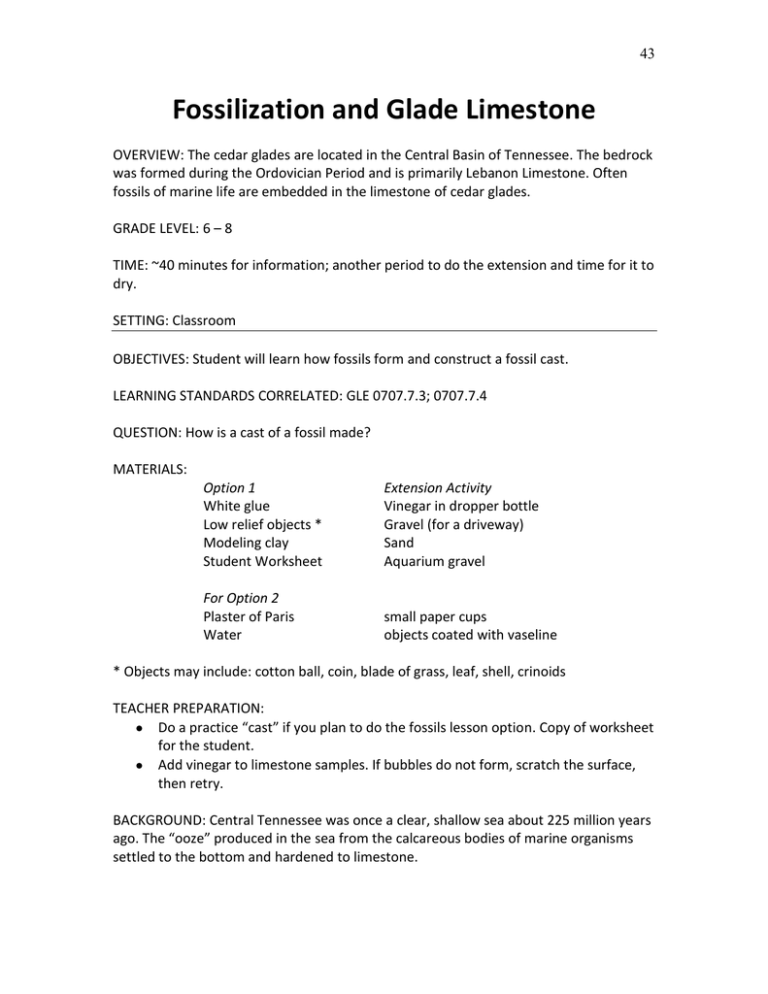
43 Fossilization and Glade Limestone OVERVIEW: The cedar glades are located in the Central Basin of Tennessee. The bedrock was formed during the Ordovician Period and is primarily Lebanon Limestone. Often fossils of marine life are embedded in the limestone of cedar glades. GRADE LEVEL: 6 – 8 TIME: ~40 minutes for information; another period to do the extension and time for it to dry. SETTING: Classroom OBJECTIVES: Student will learn how fossils form and construct a fossil cast. LEARNING STANDARDS CORRELATED: GLE 0707.7.3; 0707.7.4 QUESTION: How is a cast of a fossil made? MATERIALS: Option 1 White glue Low relief objects * Modeling clay Student Worksheet Extension Activity Vinegar in dropper bottle Gravel (for a driveway) Sand Aquarium gravel For Option 2 Plaster of Paris Water small paper cups objects coated with vaseline * Objects may include: cotton ball, coin, blade of grass, leaf, shell, crinoids TEACHER PREPARATION: Do a practice “cast” if you plan to do the fossils lesson option. Copy of worksheet for the student. Add vinegar to limestone samples. If bubbles do not form, scratch the surface, then retry. BACKGROUND: Central Tennessee was once a clear, shallow sea about 225 million years ago. The “ooze” produced in the sea from the calcareous bodies of marine organisms settled to the bottom and hardened to limestone. 44 To summarize a long geologic history, what follows is the “rock story” of the Cedar Glades. Forces within the earth pushed limestone and dolomite layers into low broad domes, eventually forming the Nashville Dome. The Ozark Dome was to its west and an arch connected the two. The arch began to erode. A sea then invaded and deposited loose sediment on top of limestone and dolomite, burying any remnants of the arch. The sea then retreated. Rocks began to rupture and move more. The Nashville Dome is hence uplifted. This uplift allowed more cracks to appear in the layers. These cracks allowed erosion to wear away the younger rock and left it on the sides, what we now know as the Highland Rim. Between the sandstone layers on the edges is our limestone that forms the Central Basin. The exposed, older rock often appears in flatter landscape. Now, imagine a flat open area of the rock now exposed, a thin layer of soil, and tough environment for most plants to survive, you have cedar glade. Middle Tennessee cedar glades are located on the Lebanon Limestone formation. Once referred to as “Glade Limestone” in 1869 because of its location, it later took the name of the nearby town of Lebanon in 1900. Lebanon shares the same underlying formation as the cedar glades nearby. The limestone has a thin layer of shale and often is filled with fossils. Various brachiopods, bryozoans, ostracods, crinoids, and gastropods dominate a rock laden with life of ancient seas. The Lebanon Limestone, like other types of limestone, reacts often with water, producing a carbonic acid, CaCO3. When this acid forms, the non-soluble part of the rock remains while the soluble part erodes. This erosion leads to creation of sinkholes and caves, characteristics of the karst landscape, which often surrounds the cedar glades. Option 1: Explain to students the differences between a fossil (ancient life preserved usually in stone), mold (the impression organism or its parts leaves in the sediment), and cast (material that fills the void or cast left by the impression). Students can work in groups or individually. Procedure: 1. Each student/group should have a piece of clay and an object. 2. Write the name of the object on the worksheet. Indicate whether each object is soft or hard. 3. Shape the clay into a pancake. 4. Very carefully, place the object into the center of the clay pancake, and apply enough pressure to make an impression on the object in the clay. 5. Slowly and carefully pull the object out of the clay without stretching or smearing the clay. 45 Note: In nature, an “object,” such as animal or plant, may rot (eaten by bacteria and fungi) and now you are acting as the decomposer when you remove your object from the clay! 6. Describe the quality of your impression on your worksheet – mark the appropriate box under the description. 7. Slowly and carefully, pour some of the white glue into the impression on the clay. Allow to dry. Note: When an organism rots beneath the soil, the space left can be filled in with minerals from the groundwater. The glue is acting as those minerals. 8. When completely dry, peel back the glue shape from the clay. If there is excess glue around your fossil, you can trim it off with scissors or your fingers. The glue shape is now a “cast” of the object you chose. 9. Indicate the quality of your cast on your worksheet. 10. Compare the quality of your cast to that of the mold. Option 2- Plaster of Paris Follow instructions on carton. Leaves and crinoids work well for this activity. Be sure to coat object well with Vaseline before making a cast! EXTENSION: To show students how limestone reacts with an acid (using vinegar to simulate acid rain), you can add drops of vinegar to a limestone rock and observe. You should see bubbles of carbon dioxide form, as summarized in the reaction: 2 CH3COOH + CaCO3 → (CH3COO)2Ca + CO2 + H20 Vinegar + calcium carbonate → calcium ethanoate (a salt) + carbon dioxide + water Try the same procedure with limestone gravel, sand, and aquarium gravel. Note: The erosion of limestone by acids, as with acid rain, is a much faster process than the erosion caused by water, which takes many years geologically. SAFETY: Avoid vinegar contact with skin, especially abrasions. JOURNALING: Research an organism that left a fossil of your choice, focusing on its habitat and other behaviors. Then, imagine the area once to be an inland sea. Choose one of the fossils and create a typical day in its life. Describe in a journal. Sources: Edwin T Luther’s book Our Restless Earth Kentucky Geological Survey Website Geology of Cedars of Lebanon State Park & Forest Clay & Chart idea is from Kentucky Geological Survey University of Kentucky http://www.uky.edu/KOS/education/white_glue_worksheet.htm 46 Name ________________________________________ Period _______ Date________ Fossil Cast and Mold Worksheet In the table, write the name of the object you are using to make your mold and cast. Place an X in the column to indicate the quality of your mold and cast. MOLD QUALITY Object Name or Description Soft or hard? None Poor Good Excellent Poor Good Excellent CAST QUALITY Object Name or Description Soft or hard? None 47 Post-Activity Questions: 1. In your own words, what is a cast? _________________________________________ ________________________________________________________________________ ________________________________________________________________________ 2. In your own words, what is a mold? ________________________________________________________________________ ________________________________________________________________________ 3. Which of the objects (name or description) you tested make the best mold of a fossil? __________________________________________________________________ ________________________________________________________________________ 4. Which of the objects (name or description) you tested make the best cast of a fossil? ________________________________________________________________________ ________________________________________________________________________ 5. Do hard or soft objects make the best casts or mold fossils? ____________________ ________________________________________________________________________ 6. Imagine a dead plant or animal was buried in the mud. What parts of the animal or plant might make good impressions based on your experiences? ___________________ ________________________________________________________________________ ________________________________________________________________________ ________________________________________________________________________ ________________________________________________________________________ 48

